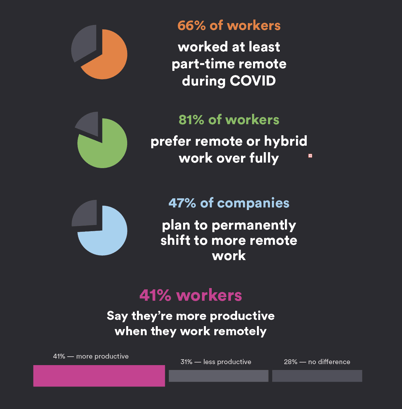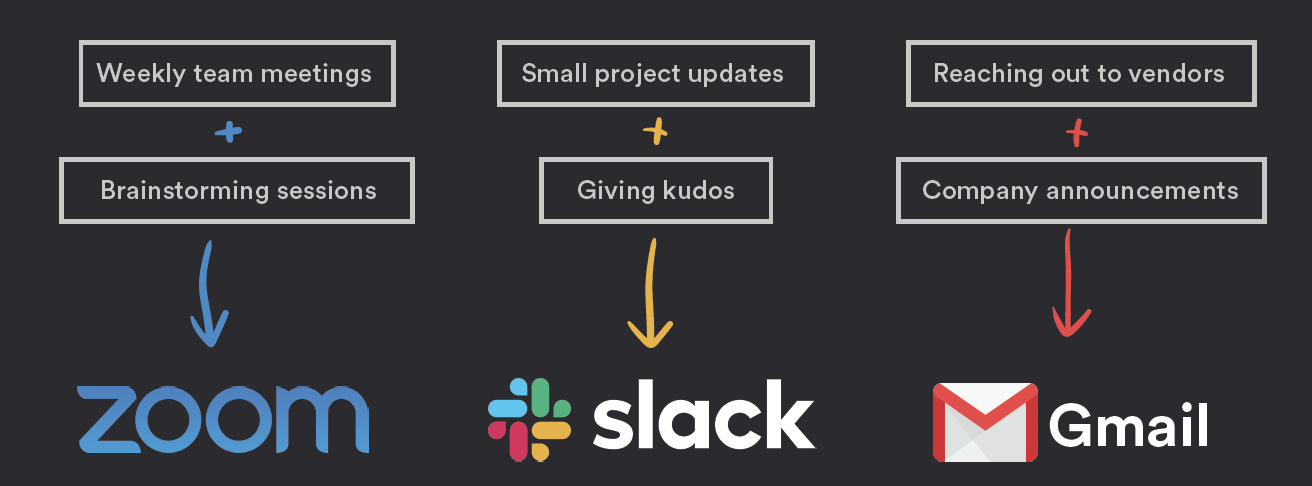
Think about what your "workplace" looked like before the COVID pandemic. Did it look ANYTHING like how it does now?
If your organization is like most, the answer to that question is likely "no".
When it comes to where employees get work done, how they communicate, and what the typical workday entails, there have been monumental shifts in many companies across most industries.
This shift presents a unique set of challenges:
- Many employees are on different schedules
- Not all team members can communicate fully face-to-face
- It's difficult to convey tone and emotion using many remote communication channels that are being used more and more
It's crucial for you as a business leader to find ways to overcome these challenges, and keep your remote or hybrid team communicating clearly and effectively
Fortunately, there are some simple tools and strategies you can use to improve your team communication despite these challenges.
Hybrid and remote teams are here to stay
As this graphic illustrates, many organizations are planning to continue having remote and hybrid teams, even as we come out of the COVID pandemic.

Working in a hybrid or fully remote team, employee communication comes with the following added variables:
- Asynchronous schedules — Not everyone receives your message when you intend them to
- Channel confusion — Many organizations have numerous communication channels to begin with, and add even more to the mix when their workplace shifts to a remote, or partially remote setup
These variables often lead to muddled communication between teams, and a disconnect when it comes to how to interpret certain messages.
Business leaders, managers, and employees all need to be on the same page about what type of communication to use when.
Here's an example of what happens when there are no communication protocols established in a remote team
Mark and Steph are two remote employees who are working on a project together. Mark tends to wake up early and get work done while emailing updates to Steph. Steph prefers to get unrelated tasks done in the morning, and hop on Zoom calls to work together on the project in the afternoon.
 Since clear boundaries and communication best-practices haven't been established at their organization, they simply default to their own communication and work preferences.
Since clear boundaries and communication best-practices haven't been established at their organization, they simply default to their own communication and work preferences.
Mark finds that the afternoon Zoom calls are unnecessary, as he spent all morning working on the project. He's "so enthusiastic about what they're working on, that he just can't wait to get things rolling each morning".
Steph often feels left-behind by Mark, as he works on the project at a time when Steph is still getting ready for the day. When she reads his emails, they seem to be devoid of any excitement for the project, and that Mark fills them with unnecessary details that are better discussed face-to-face.
This leads to miscommunication on what needs to get done, and causes friction between Mark and Steph about who's preference is best for the project. They both become bitter, and the project stalls out.
How could this have been avoided? By doing the following:
Step 1: Establish clear communication protocols in your remote and hybrid teams.
Communication protocols should cover a few things:
- What communication channels your organization uses
- When to use each one of these channels
It's important that your employees have a deep understanding of how to choose which channel to use for different types of communication. Without doing this effectively, your employees will fall into whatever they're most comfortable with — oftentimes leading to poor communication.
Here's a simple example of what you need to put together for your employees:

Take the time to analyze the current communication channels that remote and hybrid teams are using. Create a list of preferred channels, and try to avoid too much overlap. For instance, you don't want to use multiple instant-messaging platforms or video conferencing softwares (unless necessary).
After you've done that, think about all of the types of communication that your remote and hybrid employees do on a daily basis. Client communications, project management, water-cooler conversations, etc.
Assign each of the "types" of communication to a single channel that fits best. Is body language critical to the success of that type of conversation? Use video conferencing. Does it require written communication between your team and a vendor? Email is the obvious choice. Making this decision is usually very intuitive, but is something that is overlooked by many business leaders.
Step 2: Hold your teams accountable for choosing the right communication channels, but be open to change.

No C-suite decision is perfect. When it comes to communication, you need to be having regular 1-on-1 conversations with your remote and hybrid employees about what's working, and what's not. They might have some valuable insights that you hadn't thought about.
At the same time, it's easy to let your communication protocols become more of..... loose suggestions. If your team members become too comfortable with breaking protocol and defaulting to their preferred communication styles, their remote and hybrid teams can slip back into becoming disjointed.
It's crucial that you communicate the reason behind why the protocols exist in the first place and how it'll help make your employees' lives easier. Gaining buy in from the get-go can help you overcome common challenges associated with workplace change.
Step 3: Keep your eyes open. The workplace is always adapting, so you should too.
We have no idea what the workplace will look like 5 years from now. Back in 2019, no one could guess that thousands of the top companies in the world would shift to fully-remote work in less than a year.
Keeping up with industry trends, general communication best practices, and new technology in the employee communication space can help keep you on your toes, and ready for whatever's next.
Make sure to schedule regular conversations with your teams, and continue to learn about what communication styles and formats work best for them. Having remote and hybrid teams can be a huge plus for many employees and save your organization money in the long-run. Like many things — when you shift to a remote or hybrid workplace, keeping your employees and stakeholders happy and your organization successful involves listening and learning.





